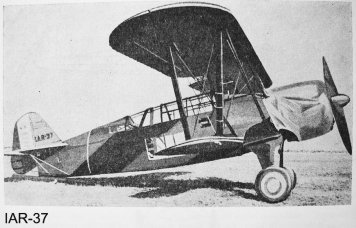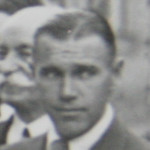
IAR 37-38-39
IAR 37 al anilor 1930, avion romanesc de recunoastere si bombardament construit de Industria Aeronautică Română.
Despre IAR 37-38-39 – Wikipedia
Rol: Recunoaștere și bombardier de lumină
Fabricant: Industria Aeronautică Română
Primul zbor: 1937
Introducere: 1938
Primii utilizatori: Romania
Număr de aeronave construite: 380
IAR 37 a fost un avion românesc de recunoaștere și bombardier de lumină al anilor 1930, construit de Industria Aeronautică Română.

IAR 37-38-39
IAR 37 al anilor 1930, avion romanesc de recunoastere si bombardament construit de Industria Aeronautică Română.
Dezvoltare
[tp not_in=”en”]Prototipul IAR 37 a zburat pentru prima dată în 1937 pentru a îndeplini o cerință de bombardament tactic și a fost un avion de recunoastere. IAR 37 a fost un biplan de golf inegal de viata unic, cu o treaptă de viteză fixă, tailwheel de aterizare, alimentat de o copie licențiată a Gnome-Rhône Mistral Major, motor radial numit IAR K14 al II-lea, cu 870 CP C32. Avea 3 locuri pentru echipaj, sub o cabina de pilotaj cu geamuri continue, pilot în față, apoi observator și un ofițer de artilerie de la spate. A avut control dublu și a fost echipat cu un bombsight, conceput pe plan local și un aparat de fotografiat. IAR 37 a intrat în producție în 1938, dar producția motorului a decalat, prevenind aeronava să fie finalizată, și a fost înlocuit pe linia de producție de către IAR 38, propulsat de motorul de încredere BMW 132. Disponibilitatea și fiabilitatea motorului K.14 imbunatatit, 37 incomplet IAR au fost montate cu IAR K.14-III, C36, cu 930 CP, pentru a permite finalizarea lor și producția s-a trecut la IAR 39, îmbunătățit, care a folosit, de asemenea, IAR K.14 IV-C32, cu 960HP. Producția totală a tuturor celor trei tipuri a fost de 380, atât la IAR și apoi a plutit, continuând până în luna octombrie 1944, majoritatea fiind IAR 39.[/tp]
[tp lang=”en” only=”y”]The IAR 37 prototype was flown for the first time in 1937 to meet a requirement for a tactical bombing and reconnaissance aircraft. The IAR 37 was an unequal-span single bay biplane with a fixed tailwheel landing gear and powered by a licensed copy of the Gnome-Rhône Mistral Major radial engine called the IAR K14-II C32 with 870 HP. It had room for a crew of three under a continuous glazed cockpit, pilot at the front then observer and a gunner at the rear. It had dual controls and was fitted with a locally designed bombsight and a camera. The IAR 37 entered production in 1938, but production of the engine lagged, preventing the aircraft from being completed,and it was replaced on the production line by the IAR 38, powered by the reliable BMW 132 engine. As availability and reliability of the K.14 engine improved, the incomplete IAR 37s were fitted with IAR K.14-III C36 with 930 HP to allow their completion and production was switched to the improved IAR 39, which also used the IAR K.14-IV C32 with 960HP. Total production of all three types was 380, at both IAR and SET, continuing until October 1944 with the majority being IAR 39s.[/tp]
Istorie operationala
[tp not_in=”en”]Aeronava a intrat în serviciu Industriei Aeronautice Romane în 1938 și, până la sfârșitul anului 1940, au echipat un număr mare de escadrile. Când România a sprijinit ofensiva germană împotriva Uniunii Sovietice,15 din escadrilele de recunoaștere,18 au fost echipate cu biplane IAR.39 IAR. Au folosit cele mai multe dintre escadrilele de recunoaștere implicate în ofensiva in1944 împotriva Uniunii Sovietice.[/tp]
[tp lang=”en” only=”y”]The aircraft entered service with the Royal Romanian Air Force in 1938 and, by the end of the 1940, they equipped a large number of squadrons. When Romania supported the German offensive against the Soviet Union 15 of the 18 reconnaissance squadrons were equipped with IAR biplanes. The IAR 39 was used by most of the reconnaissance squadrons involved in the 1944 offensive against the Soviet Union.[/tp]
[tp not_in=”en”]Atunci când noul guvern post-război a fost format în 1947, un număr mai mic de IAR 39 a fost utilizat de către Forțele Aeriene Române de formare și de legătură.[/tp]
[tp lang=”en” only=”y”]When the new post-war government was formed in 1947, a smaller number of IAR 39s were used by the new Romanian Air Force for training and liaison.[/tp]
Variante
IAR 37
Producție inițială, cu motor IAR K14-II C32 – 649 kW (870 cp). 50 construite
IAR 38
Cu motor 522 kW (700 cp) BMW 132A motor unravailability de K14. Coadă Taller. 50 construite
IAR 39
Versiunea revizuită a modelului IAR 38 revenind la motorul IAR K.14-III C36 – 690 kW (930 cp). 95 construite
IAR 39A
Motor IAR K.14-IV C32 716 kW (960 cp). 160 construite

IAR 37-38-39
IAR 37 al anilor 1930, avion romanesc de recunoastere si bombardament construit de Industria Aeronautică Română.

IAR 37-38-39
IAR 37 al anilor 1930, avion romanesc de recunoastere si bombardament construit de Industria Aeronautică Română.

IAR 37-38-39
IAR 37 al anilor 1930, avion romanesc de recunoastere si bombardament construit de Industria Aeronautică Română.
Specificatii (IAR 39)
Date din The Illustrated Encyclopedia of Aircraft (Part Work 1982-1985), 1985, Orbis Publishing, Pg. 2192
Caracteristici generale:
- Echipaj: 3
- Lungime: 9.60 m (31 ft 6 in)
- Anvergura: 13.10 m (42 ft 11¾ in)
- Înălțime: 3.99 m (13 ft 1 in)
- Suprafata portanta: 40.30 m2 (433.80 ft2)
- Greutate la gol: 2177 kg (4799 lb)
- Greutate brută: 3085 kg (6801 lb)
- Motopropulsor: 1 × IAR K.14-IV C32 piston radial, 716 kW (960 cp)
Performață:
- Viteza maximă: 336 km/h (209 mph)
- Interval: 1050 km (652 mile)
- Plafon Servicii: 8000 m (26,245 ft)
Armament:
- 3 x FN (Browning) mitralieră de 7.92 mm (0.31 in)
- 288kg (635lb) de bombe grenade







